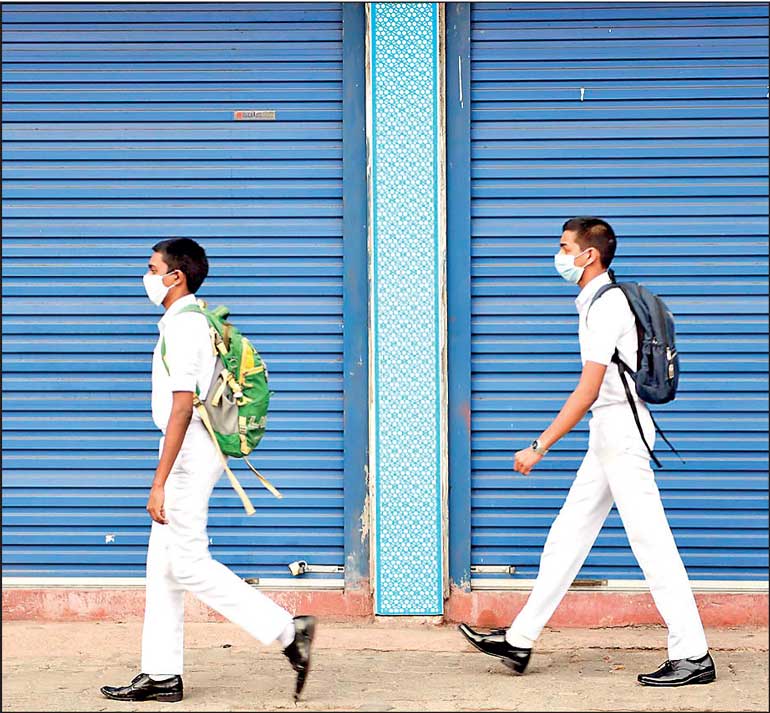Sunday Apr 20, 2025
Sunday Apr 20, 2025
Wednesday, 29 June 2022 00:00 - - {{hitsCtrl.values.hits}}

Weightage of the bag is something related to ‘quantity’ which we need to revisit while improving the ‘quality’ – Pic by Shehan Gunasekara
 Now we are witnessing the worst economic crisis in Sri Lanka with all the hardships for common people. As per my reading, all we can see are only the ‘symptoms’ of the ‘real problem’ and underlying causes need to be investigated. In this scenario, I observe the ‘education system in Sri Lanka’ as part of this ‘real problem’.
Now we are witnessing the worst economic crisis in Sri Lanka with all the hardships for common people. As per my reading, all we can see are only the ‘symptoms’ of the ‘real problem’ and underlying causes need to be investigated. In this scenario, I observe the ‘education system in Sri Lanka’ as part of this ‘real problem’.
As we know, with the blessings of ‘free education’ by Dr. Kannanagara, Sri Lanka has advanced in education in the past. You can explain this with a better literacy rate as one indicator. Unfortunately, the education system has not changed for years aligning with the requirement of society. I have seen certain experts discuss different best practices in education in countries such as Sweden in many forums in Sri Lanka but no real impact on the system itself. We have witnessed many negative outcomes (in terms of deteriorating the quality of people in society, ranking of education in Sri Lanka) by questioning the ‘quality education in Sri Lanka’. In this article, I am going to discuss one facet of this ‘real problem’ and which is related to the ‘size of the schoolbag’ which I consider part and parcel of this problem.
In Sri Lanka, we can observe a student weighing 25 kilos bringing a schoolbag of 10 kilos! I consider this as one measurement to indicate the disaster of our education system. Most of the children coming under the category of grades six to 10 have around 10 subjects per day questioning whether Sri Lankan educationists have done the justice for our next generation (which we need to discuss in a separate article).
In India, the Ministry of Human Resource Development (HRD) prescribed a weight limit of schoolbags for each class last year. Accordingly, the weight of schoolbags for students of classes one and two should not exceed 1.5 kg, while the schoolbag of students of classes three to five should weigh between 2 kg to 3 kg. The schoolbag of students in classes six and seven should not be more than 4 kg, while the weight of schoolbags of classes eight and nine students should not be above 4.5 kg. The schoolbag of a class 10 student should not weigh above 5 kg. Even in Peshawar, Pakistan the elementary and secondary education department has decided that the schoolbag’s weight will not be more than 15% of the student’s.
It can be observed that a grade seven student in Sri Lanka is bringing more than 200% of the stipulated weight limit which would lead to many ergonomic problems. A report by the US Consumer Product Safety Commission published that over 22,000 students suffer back pain-related injuries in the year 2013 (Khan, 2018). The majority of them carry as much as 25% of their body weight.
A study in Al-Ahsa, Saudi Arabia, reveals that 1,860 (around 73%) of the students among 2,567 students carry bags that weigh more than 15% of their body weight and back pain was reported by 42% of the students. In India, the burden of satchels, as estimated in some of the Telangana districts, weighs about 6 to 12 kg at the primary level and 12 to 17 kg at the high school level (Khan, 2018). In Sri Lanka, it can be suggested to have a proper study on this to investigate the gravity of the problem with a weight limit of schoolbags.
There is a grave need for a revisit of the education system in Sri Lanka in terms of many aspects. But in this article, I would like to emphasise ‘the quantity vs. quality’ of the education system of the country. Weightage of the bag is something related to ‘quantity’ which we need to revisit while improving the ‘quality’. As I mentioned earlier this is one of the symptoms of the ‘real problem’ we are facing in the country and authorities should take this seriously as a matter of priority.
(The writer is a Professor in Management Studies, Faculty of Management Studies, The Open University of Sri Lanka. You can reach him on [email protected].)